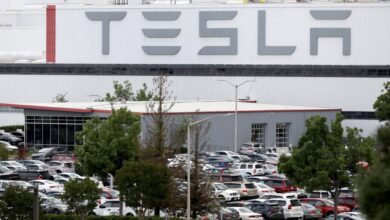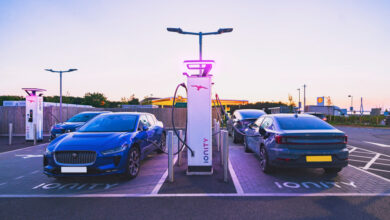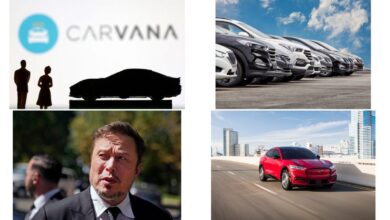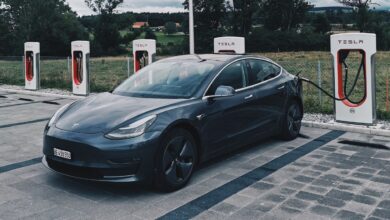Electric Vehicle FAQs
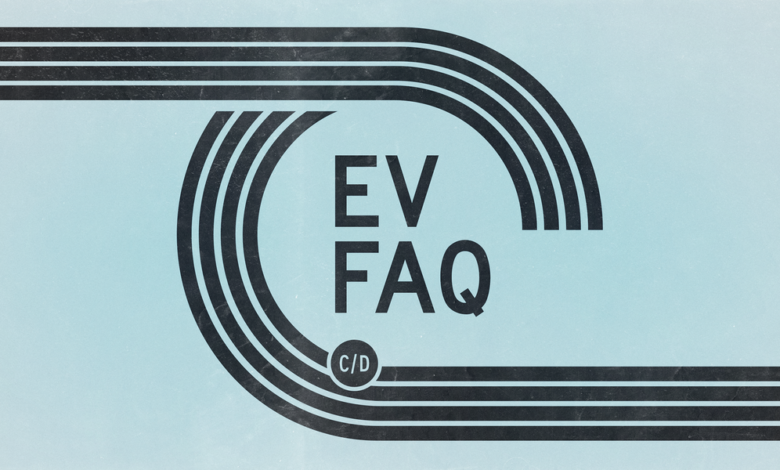
It’s only taken about 100 years, but electric vehicles are once again becoming viable competitors to gasoline-powered automobiles. Virtually every automaker now either offers one or more EVs or has them coming soon. Several independent EV manufacturers have sprung up seemingly overnight to challenge both Tesla and the long-established carmakers. Battery technology is improving steadily, and EVs are becoming more affordable. Charging networks have grown across the country that make both daily driving and long-distance travel in EVs feasible, if not entirely convenient. But they’re far from perfect. If you’re thinking of purchasing an EV or just want to know all about them, we’ve pulled together this list of frequently asked questions and done the investigative homework to answer them for you.
1. What’s the Real Story on EV Range?
The one consistency with EV range is that it varies, tremendously. In areas with a moderate temperature, with minimal to zero use of the climate control, lithium-ion batteries are in heaven. They’ll deliver and sometimes overshoot their estimates. But anywhere else on earth where the seasons vary from freezing cold to blistering hot, EV range is dramatically and disproportionately affected by ambient temperature when compared to a gas-powered car.
The usual factors that determine a car’s range—aerodynamics, tire size, weight, the driver’s aggressiveness—have a larger impact on EVs. Even when an EV achieves the equivalent efficiency of 100 miles per gallon, it’s only carrying the equivalent of two to six gallons.
An EV’s EPA range—the figure that appears on the window sticker—is more of a best case scenario than what you might count on in any driving scenario. For example, the EPA’s test cycles are performed at far lower speeds as typical highway driving. When we test EV range, we perform a constant 75 mph in Michigan, with the climate control set at 72 degrees across all seasons, where the roads are relatively flat. We do not test with the ambient temps are below 32 degrees or blazing hot. We note the state of charge and estimated range every five miles until we can no longer achieve that speed or we’re at risk of running empty. The final number is an estimate calculated from these points and fit to a curve, rounded down to the nearest 10-mile increment. The average result in our test is a highway range that is 13 percent less than the window-sticker value, and it’s rare that any EVs match or exceed their range figure (all of ones that have are from German automakers). On the other hand, gas-powered vehicles typically exceed their EPA highway figures by a few percent in our test.
2. Does Cold Weather Reduce an EV’s Efficiency or Performance?
Imagine waking up to a car that lost a substantial amount of fuel overnight. That’s what can happen to an unplugged EV sitting outside in freezing temperatures. The cold slows down battery chemistry and results in less energy output. Today’s lithium-ion chemistry simply cannot sustain electrical charge in normal winter conditions. On EVs that have resistive heaters instead of heat pumps, running the cabin heat uses substantial energy from the battery. In a test with our long-term Tesla Model 3, we found that using a modest amount of heat increased consumption by 17 percent and killed 30 miles of range compared with running with the climate off.Hot summers are another EV enemy, especially in searing climates like in Las Vegas or Phoenix. Not only will you require heating or cooling inside the cabin, so will the battery. Not to mention, the battery packs do not like to be frozen or boiled, so even a parked vehicle may use energy to heat or cool the pack. The vehicle’s thermal management system helps keep the battery at an efficient operating temperature but draws a significant amount of energy. Figure a 20- to 30-percent drop in range in extremely cold or hot conditions.
3. How Does EV Fast-Charging Work?
There are four types of plugs: Tesla (NACS), J1772, Combined Charging System (CCS)—which is a J1772 plug with the two pins at the bottom for DC charging—and CHAdeMO. But nearly every automaker is in the process of migrating to Tesla’s connector, which is now finally living up to the name Tesla gave it, the North American Charging Standard (NACS). Public stations other than Tesla are managed by three main companies: Electrify America, EVGo, and ChargePoint. No public charging stations are staffed, and they don’t tend to have efficient customer service. Station connectivity errors, low output, and failures are common. Tesla’s Superchargers have been the most reliable, but since the company has started to allow non-Tesla EVs to charge there more issues have cropped up. To plan any kind of trip with an EV, you will have to research the number, location, and types of chargers along your route before going anywhere and drive knowing that there could be failures that could prevent you from reaching your destination on time.
4. Which EVs Have the Longest Range?
EVs that cost more than $80,000 have the longest range of 400 or more miles per charge. The one exception is the Hyundai Ioniq 6, which has an estimated 361-mile range for just over $40,000. EVs with 300 or more miles typically cost no less than $50,000. The current range champ is the Lucid Air Grand Touring with EPA-rated 500 miles; it also tops our highway-range-test leaderboard with 410 miles. It retails for $112,475.
5. How Do EV Tax Credits Work?
The credits reduce a filer’s federal income tax for the year up to $7500, subject to price and income caps. EV tax credits are nonrefundable. This means they can only be applied to tax owed in the year in which you took delivery. Businesses, however, can transfer new EV tax credits to future years. When leasing a new EV, the dealer technically gets the credit but will typically lower the buyer’s lease payments by the amount of the credit. There’s a lesser tax credit available to buyers of used EVs, a maximum of $4000, that are at least two years old and purchased from a dealer. There is an additional tax credit available for 30 percent of the cost of EV charging equipment and installation at your home, up to a maximum of $1000.
6. How Long Does It Take to Charge an EV?
There are three levels of charging. Level 1 uses the J1772 plug or Tesla connector that runs to a large adapter which then connects to a standard 120-volt AC household outlet. It typically provides no more than 12 amps or 1.4 kilowatts of energy. As such, it is the slowest and really should only be used when there are no other options. It can take days for a full charge.
Level 2 chargers can run up to 80 amps at 240 volts, depending on the electric circuit and the charging unit. EV owners will want Level 2 charging installed at their home, although typically 40 to 50 amps (i.e., 9.6 to 12.0 kW) is plenty (most EVs can’t charge at the fastest Level 2 rate anyway). Every EV’s onboard charger limits how much energy it can draw from a Level 2 charger, so this will be the final limiting factor. It can take anywhere from eight or more hours to fully charge an EV on a Level 2 connection, which is why automakers recommend it for overnight charging. Level 3 chargers use direct current. This type of electrical service is restricted to commercial use. Tesla Superchargers are Level 3. Other Level 3 charging stations use CCS and CHAdeMO, the latter of which was used exclusively by Asian automakers and is being phased out. Level 3 chargers range from 50 kW to as much as 350 kW, but these are max figures and are never sustainable during the entire charge.
7. Won’t the Life of the Batteries in an Electric Car Be Reduced within a Few Years Due to Constant Use—Like Those in Cell Phones?
Yes. EV batteries use a lithium-ion chemistry similar to every portable electronic device. They will age from time and cycling, or how many times a battery is depleted and charged. Fast-charging on a Level 3 connection causes more heat buildup and degrades batteries faster than a Level 2. Charging the battery above 80 percent or letting the battery dip below 20 percent also causes more wear and reduces life.
However, auto manufacturers engineer vehicle batteries to significantly outlast what’s in an iPhone. This is done in part by reducing the operating capacity of the battery so it never fully charges or empties (even if the display that the driver sees says otherwise). It should also ease your concern to know that every new EV comes with a battery warranty that spans at least eight years or 100,000 miles (or 10 years or 150,000 miles in states that follow California emission laws). As with all warranties, the specific details and exclusions vary among automakers, but the typical approach is to guarantee a certain amount of battery capacity—80 percent or so—at the end of the warrantee period. If your vehicle’s battery degrades past that point, the automaker will replace it.
8. When Will There Be an EV That Can Do a Day’s Worth of Driving (700-Plus Miles) without a Recharge?
That type of driving range is longer than what many internal combustion-engine cars can manage on a single tank of gas, but it would conceivably go a long way toward convincing more people that an EV could work for them. Samsung has developed a solid-state battery that it claims has the potential to provide close to that amount of range, as well as faster charging times and long life. But no one is saying when this technology will be available and affordable for use in electric cars.
9. Do EVs Really Pollute Less When Considering Both Manufacturing and Operating Emissions?
That’s a complicated question, and the answer is nuanced. The easy part is that EVs certainly reduce greenhouse-gas emissions at the source—meaning at a car’s tailpipe, since an EV has no tailpipe—compared with gasoline-powered cars. But an EV’s emissions are happening elsewhere, and it depends heavily on where the energy comes from that’s used to recharge. Still, studies have found that on average in the U.S.—including the cleanliness of the varying power sources—EVs do reduce greenhouse-gas emissions. But EV batteries also require a huge amount of fossil fuels to manufacture their batteries, many of which take immense amounts of fossil fuels to extract and process. Cobalt, nickel, lithium, and manganese—key battery minerals—are limited in supply and, as with oil production, mining operations can be hazardous to surrounding communities by contaminating water and air.
10. Does an EV Battery Lose Its State of Charge while the Vehicle Is Turned Off?
Yes. Every battery ever made self-discharges. Newer lithium-ion batteries are better at maintaining their state-of-charge than certain other types of batteries, but there is still some level of self-discharge. In addition, when an EV is parked in extreme ambient conditions it uses energy to either heat or cool the battery pack to keep it at a safe temperature. If you’re planning to escape cold weather with a mid-winter vacation for a week or two, you will want to make sure the airport parking lot has EV charging or you could come back to a flat battery.
11. Is It Safe to Drive an Electric Car in a Flood?
Regardless of whether it’s an electric car or one with an internal-combustion engine, it is never safe to drive on a flooded road. Electric cars have significant protections built in to reduce the chances of electrocution, and there are measures to make sure components do not become contaminated by moisture, but full submersion is a different story. Even if you drive into a flood by accident you likely won’t die from electrocution in an EV. But just be smart and don’t drive into any sort of deep water in any vehicle.
12. How Does Using an Electric Car’s Heater during the Winter Affect Its Range?
Since there are so many possible variables involved in answering this question, we’ll summarize the results of our test with a Tesla Model 3. At an outside temperature of 38 degrees Fahrenheit, with the Tesla fully warmed up, we conducted three tests at 70 mph. Compared with the HVAC system completely off, we saw an approximately 17-percent increase in energy usage with the heater set to 72 degrees. With the heat turned up all the way—including all five heated seats on high—the car consumed 35 percent more energy than the everything-off baseline. The difference in this case between no heat and full heat was about 60 miles of range, or roughly 20 percent of the Model 3’s 310-mile EPA rating. While the Model 3 uses a cheaper—albeit less efficient—type of heater than some other EVs, the long and short of it is that an electric car’s heater can dramatically impact efficiency and range—how much just depends on how warm you want to be and how cold it is outside.
13. When Are Electric Cars Going to Be Affordable?
Some new EVs are plenty affordable, like the Nissan Leaf which starts under $30,000 before tax credits. Many late-model used EVs are very affordable ($25,000 or less) even without the used EV tax credit.
14. What Are My EV Choices?
There are dozens of electric vehicles on the market today, including a handful of hydrogen fuel-cell electric vehicles, in nearly every size and segment.
15. Are There Any Great Lease Deals on EVs?
Yes. A $7500 leasing credit applies to any electric SUV or truck that retails for $80,000 or less and any car that retails for $55,000 or less.
16. Can I Buy a CPO EV?
Yes, and any Certified Pre-Owned car, SUV, or truck offers numerous positives, from an extended factory-backed warranty to the repair of any defects before the vehicle is sold by a participating dealer. You have to decide if that extra peace of mind is worth the higher price.
17. Is an EV Less Expensive to Own and Operate Than a Regular Gas-Powered Car?
Generally EVs will be more expensive to purchase but less expensive to operate. You will have to make a calculation for how you drive and the specific EV you are purchasing. We ran a detailed analysis that explains how to properly make this calculation.
18. Does an EV Work for a Long Trip?
Yes, and we’ve done plenty of them ourselves, from cross-country treks, to a 1000-mile loop from our Michigan HQ around Ohio and back during our EV1000 event, and a 1100-mile trip from Michigan to Florida in our long-term Rivian R1T. Tesla’s sprawling Supercharger network makes long road trips easier in its vehicles, although with more and more of them open to non-Tesla vehicles should make it better for others. Sure, stopping to charge will take longer than refueling at a gas pump, but if you plan ahead with your charging stops—A Better Route Planner is a great tool—and stay overnight at hotels with charging, you can minimize the inconvenience. And most people want to get out and stretch every few hours anyway.
19. How Long Have There Been EVs?
We’d bet that many people think of electric vehicles as a relatively new method of transportation, but history says otherwise. Electricity has actually been competing with gasoline—and steam—to power automobiles since the very dawn of the horseless carriage. Today’s modern EV miracles such as the Tesla Model S and the Porsche Taycan were preceded by more than a century of electric-powered automotive experiments.
Dave VanderWerp has spent more than 20 years in the automotive industry, in varied roles from engineering to product consulting, and now leading Car and Driver‘s vehicle-testing efforts. Dave got his very lucky start at C/D by happening to submit an unsolicited resume at just the right time to land a part-time road warrior job when he was a student at the University of Michigan, where he immediately became enthralled with the world of automotive journalism.
Clifford Atiyeh is a reporter and photographer for Car and Driver, specializing in business, government, and litigation news. He is president of the New England Motor Press Association and committed to saving both manuals and old Volvos.
